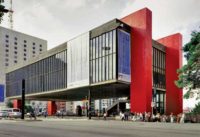The relationship between architecture and nature rarely gets more explicit than with rammed-earth construction. The 18-foot-high western exterior wall of the Nk’Mip Desert Cultural Center in Osoyoos, British Columbia, stretches for 260 feet, making it the longest rammed-earth wall in North America, according to Vancouver-based Hotson Bakker Boniface Haden Architects (HBBH). But the size is downplayed by the ruddy material, much of which was excavated on-site to capture the desert colors of the South Okanagan Valley.
Bruce Haden, a principal at HBBH, says he tried to resist the traditional choice of ersatz regional architecture, like that found in Santa Fe’s fake adobe buildings. “We wanted a building that was simultaneously modern and spoke to the landscape and the contemporary traditions of the Osoyoos Indian Band,” he says. Although the 12,000-square-foot center—used as an exhibition and meeting space by the Osoyoos—disappears behind the earthen wall and under a vegetated roof, these two highly visible sustainable design elements support a comprehensive energy-efficient project that also relies on radiant heating and cooling.
The west-facing, 24-inch-wide rammed-earth wall, bolstered with an internal layer of Styrofoam insulation, performed well enough to resist summertime temperatures that can reach 100 degrees F. The wall consists of local dirt, with organic matter filtered out, combined in a mix of 10 percent concrete and color additives (to get that clean, layered look). Contractors from British Columbia’s Terra Firma Rammed Earth Builders laid down each strip and then mechanically tamped it down to 50 percent of its original height. Haden says it was more labor intensive and expensive than concrete, but his hope is to encourage more rammed-earth architecture in the region by training locals in the construction methods. “If this could become a more generic material, it could foster a modern and regional aesthetic,” Haden says.









Post a comment to this article
Report Abusive Comment